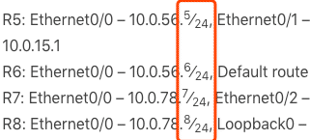A list about how I customize Hugo and why I did the change, the post will be updated continuously.
1. fractions
Network Engineer should care about this, because it shows wrong IP/mask format with default value:
Disable it in config.toml:[blackfriday]
fractions = false2. hrefTargetBlank
This default value of the option is false which means external links(The wording was corrected to “absolute” from ’external’ on Hugo official doc).
I prefer to change the value to true.
3. baseurl and canonifyURLs
canonifyURLs option should be to true for SEO purpose, baseurl should be configured at the same time. For my case (config.toml):
baseurl = "https://blog.gainskills.top"
canonifyURLs = trueThen, add following content to Hugo template:
<link rel="canonical" href="{{ .Permalink }}">The site might be failed to load on local machine after the change because it failed to bind to the domain. The resolution is: add --baseURL when running Hugo locally.
./hugo_osx/hugo server --baseURL http://127.0.0.14. .Pages or .Site.RegularPages
Since .Pages contains the urls of tag/category page, I prefer to use .Site.RegularPages for sitemap/robots.txt.
5. structured-data
Following Google Docs for structured-data.
Tools
6. Asset minimization
Update @ Mar-09-2019
With this feature, the resource will be minified for better performance
Location of the static resource
Moving the static resource to the folder: assets. You can check the theme repository as an example.
The way to call the resource
resources.Getwill be used instead of linking the resource directly. Here is the sample:<!-- Custom CSS --> {{ $huxcss := resources.Get "css/hux-blog.css" }} {{ $huxstyle := $huxcss | resources.Minify }} <!-- JavaScript --> {{ $jqueryjs := resources.Get "js/jquery.js" }} {{ $jqueryscript := $jqueryjs | resources.Minify }} <script src="{{ $jqueryscript.Permalink }}"></script>
Scan the QR code using WeChat
